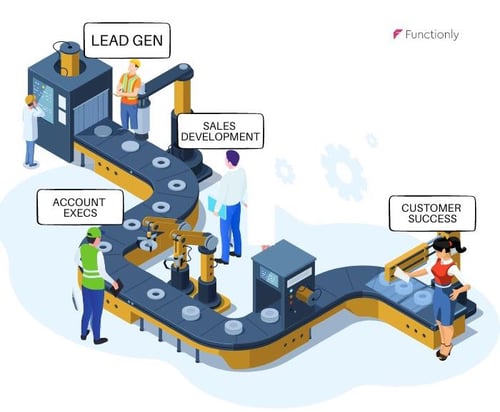Revenue is at the heart of any business. Without it, a company ceases to exist. With sales comes the opportunity to grow the organization and eventually scale it for further success.
However, you’ll need an effective sales team before you can expand your revenue. Your employees must have the resources and tools they need to advocate for your company’s products or services. They’ll also need an efficient organizational structure that positions them for success.
What Factors Should a Company Consider When Establishing a Sales Team?
Setting up a sales team isn’t easy. There are a lot of components to consider, such as hiring the right people, setting up a compensation arrangement, and implementing goals. You’ll also need to determine how to structure your sales department. Let’s examine the essential factors when forming your team.
-
Decide How You’re Going to Hire
Whether you’re hiring a single sales associate or a whole team, you’ll need to determine what the purpose of each sales employee is.
Some organizations require sales professionals with lots of experience in a specific market sector. In contrast, others are willing to try out someone with little training and develop their skills to meet the organization’s needs.
Business requirements are crucial to determining who you need. If your current sales team is flagging along without direction, you’ll want a sales manager who can pull the team together, set goals, and measure their success. If you’re seeking to break into a new market or region, you’ll want someone familiar with the industry or territory.
-
Ensure Your Team Has the Right Tools to Sell
Sales is quite different from what it was thirty years ago. In the past, sales professionals relied on cold calling and their business storefront to bring in clients who needed their products or services, but that isn’t the case today.
Today’s sales professionals rely on a marketing and technology-driven process that allows them to target specific consumers for their services.
Thus, you’ll want to ensure that your sales team knows how to reach out to targeted customers to describe how your company’s product can benefit them.
Many companies today use a process of sales funnelling, where they build up their credibility through content marketing and advertisements. The internet provides a wealth of opportunities for sales professionals, and providing your sales team with the resources they need to be successful is crucial.
Sales teams need the right tools to progress their sales funnel.
-
Establish Your Compensation Structure
Many sales professionals rely on a hybrid of salary and commissions for their compensation. However, other organizations provide a salary that only changes with the cost of living. Some companies choose to offer a commission-only remuneration structure.
Compensation arrangements often vary with the company's products or services. For example, a real estate agent usually only receives commissions. However, selling a single house may result in a paycheck worth thousands of dollars. Thus, a real estate agent has the incentive to build their client base and constantly look for new leads.
Companies who provide set salaries to their sales staff without commissions sometimes find that their agents aren’t as willing to get out and do their job. After all, if there’s no bonus in it for them, there’s no reason to work extended hours, get out and build leads, or try new sales tactics.
Those who use a hybrid structure allow for a basic salary with no fluff. However, earnings aren’t limited, and the sales agent has more incentive to bring in new business.
-
Set the Right Goals
If no one knows what they’re working toward, there’s nothing to achieve. Thus, effectively encouraging the sales team to work toward new goals each quarter and year sets a baseline for expectations.
For instance, consider your personal goals. Perhaps you’d like to lose weight over the next three months. You set your goal as “lose weight,” But you don’t define how much you’d like to lose or how you plan to do it. You could lose one pound in water weight and declare yourself successful, but chances are that’s not really your goal.
A better way to define goals is through measurable targets. For example, you could decide you’d like to lose 2% of your body fat and be able to run three miles without stopping. Those are clear-cut, defined goals. To meet your objective, you can design a diet and exercise program and work toward your target in an organized fashion.
When developing sales goals, you’ll want to take the same steps. If you want your sales team to achieve a 10% increase in sales over last year, set it as an annual revenue target. Then, establish achievable short-term goals that the team can work toward to build their confidence and see that the long-term objective is within their reach.
For example, you could set a quarterly goal of increasing sales by 2.5% each quarter. If the sales team meets each target, they’ll achieve the annual goal of 10% growth in revenue.
-
Measure Your Sales Team’s Progress
While establishing clear-cut goals is part of the process, so is measuring them. However, measurement shouldn’t happen at the end of the quarter. It should be something that occurs regularly, on a weekly or bi-weekly basis.
Investing in customer relationship management (CRM) software is an excellent way to measure your sales team’s effectiveness. CRM software tracks each client throughout the sales pipeline, from lead generation to customer success. You can easily monitor when your sales team is performing above expectations or when they need a jump-start to close clients.
Regular meetings to discuss CRM metrics and overall sales processes are vital to monitoring progress. No one wants to find out at the end of the year that they’ve failed at their revenue efforts — or worse, lost sales altogether.
-
Develop the Right Organizational Structure
Finally, you’ll want to choose the right sales organizational structure that aligns with your company’s strategy. Typically, businesses choose between three types of organizational structures: the island, the assembly line, and the pod. Each one has certain advantages and disadvantages and works well with different types of organizations.
Usually, sales team structure is determined based on three factors: the size of the sales team, the volume of transactions, and organizational objectives.
What Are the Options for a Sales Team Organizational Structure?
There are three main types of organizational structures for sales teams: the island, the assembly line, and the pod.
-
The Island
An island organizational structure is what most people think of when they consider sales. In an island structure, each sales representative works on their own. The sales representatives receive essential information about the product or service and basic training to get them going. Then, it’s up to them to find clients and land deals.
Island structures work well for organizations whose products and services aren’t too complex and have a high level of transactions. Real estate agents and financial service professionals are well-known examples of market sectors that traditionally follow the island sales model.
The most significant advantage to the island organizational structure is the reduced need for individual supervisory oversight.
Most companies that use the island structure see their sales agents as individual enterprises who are responsible for building the brand name but who use their respective capabilities to generate leads and oversee the sales process from end to end.
There are several disadvantages to the island structure:
-
Since the sales representative has the authority to generate business for the company, they primarily act of their own volition. One sales agent's methods may differ entirely from another’s, and the way they obtain clients may not align with the organization’s values.
-
In addition, sales agents are competing against one another. Competition can easily lead to aggressiveness, with agents acting in their own interest to acquire clients. Teamwork can quickly fall by the wayside.
-
It’s also difficult to monitor your sales team’s performance under an island structure. Setting up metrics and measurements can be tricky since each agent owns their processes and is less likely to be interested in fulfilling the organization's overall goals.
-
The Assembly Line

An assembly line structure breaks the sales team apart into separate functions. While the island structure requires the sales agent to retain responsibility for each part of the sales process, that’s not the case with the assembly line structure.
Under an assembly line arrangement, each team member retains ownership of specific parts of the sales process. This organizational framework generates more efficiency by holding several people responsible for different tasks in the sales function.
Usually, there are four different divisions in an assembly line sales team. They include lead generation, sales development, account executives, and customer success.
The lead generation team handles the process of finding new clients. The group obtains the contact information of potential customers and attempts to funnel in new clients using different tactics. For example, lead generators may attend industry events, develop whitepapers, and collaborate with marketing to target potential customers.
Sales development representatives are responsible for following up on leads. They engage with potential customers to further develop the sales process and convey how the organization’s products or services could benefit them. Once a lead is qualified, the sales development representative passes their details to an account executive.
Account executives close deals with customers. They perform in-depth product demonstrations, answer client questions, and try to finalize the sale. If the client has objections to the product, account executives try to manage them. They also negotiate the terms of a deal with clients.
Finally, the customer success team ensures that clients remain satisfied with their products or services. They’ll answer any questions that arise and may attempt to sell customers new products and services if the opportunity emerges.
The assembly line sales structure is much easier to manage than an island. Since sales functions are distributed amongst various roles, it’s easier to pinpoint where problems lie.
For example, if sales are down 10% for the quarter, the sales director would analyze the performance of each sales division. Problems with customer retention point to issues with the customer success team, while a reduction in closed deals may signify obstacles with account executives or sales development representatives.
An assembly line structure creates more specialization, resulting in more significant optimization. Each division is responsible for specific processes, and they have the opportunity to better develop and hone in on their talents.
There are a few disadvantages to the sales assembly structure.
-
This structure doesn’t work well with new startups that have only one or two salespeople. While specific sales tasks can be divided between two individuals, there won’t be enough people to fully develop an assembly line structure.
-
Customers can become confused as they move through the sales funnel. Individuals they’ve come to know in the beginning stages of the sales process hand the client over to others as they move through the sales funnel. Thus, the client must build a new relationship with each person they speak to.
-
Sometimes, company messaging concerning products or services is lost as clients meet new individuals in the sales organization. For example, a lead generator may advise the customer that the service will provide specific benefits, but an account executive may negate that statement. Differing messages can lead to frustrated customers.
-
Finally, the sales team can lose sight of the company’s overall sales goals. They may become too caught up in their metrics to worry about those of the organization.
-
The Pod

The pod structure uses the roles of the assembly line but forms them into individual groups. For example, each pod may consist of one lead generator, a sales development representative, an account executive, and two customer success representatives.
An organization can have multiple pods following the same arrangement.
The pod structure's advantage is that each team focuses on the same customers. The pod slowly moves each customer through the sales journey. Once a deal is closed, the client communicates with the customer success representatives.
When working in pods, there is less competition between roles, and the team focuses on the customer during each step of the buying process. Greater communication between positions ensures everyone fulfills their tasks and keeps the customer happy.
However, there are a few drawbacks to the pod structure:
-
Since everyone is working in a team, there’s less potential for individual success and competition. While you may have a few star sales reps, they may not be as visible in a pod structure.
-
The pod structure requires everyone in the pod to focus on customer activities, no matter where they are in the buying phase. Everyone provides input across roles, and the individual specialization between functions may be lost.
A Successful Organizational Structure
Setting up a sales team organizational structure isn’t easy. In the early days of the company, an island or assembly team arrangement may work best. However, transitioning to the pod may be more effective as the company scales.
Organizational structures aren’t the only concern; you’ll also need to decide how to hire and pay your sales agents.
At Functionly, we offer streamlined, interactive organizational chart development and strategy-building solutions. Sign up for free to reduce administrative inefficiencies and elevate your company’s resource capacity.






